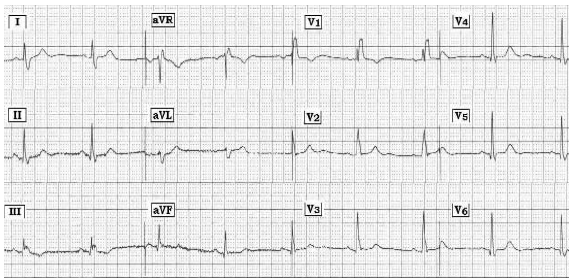ECG Review
What Happened in the Past?
 |
By Ken Grauer, MD, Professor, Department of Community Health and Family Medicine, University of Florida. Dr. Grauer is the sole proprietor of KG-EKG Press, and publisher of an ECG pocket brain book.
Clinical Scenario
The ECG shown above was a baseline tracing obtained during the initial visit with a new primary care provider. How would you interpret the tracing? What do you suspect happened in the past?
Interpretation
The rhythm is sinus bradycardia with a rate in the low 50s. The PR interval is normal, but the QRS complex is widened. QRS morphology is consistent with complete right bundle branch block (RBBB). The finding of note is the presence of multiple narrow q waves in the inferior and antero-lateral precordial leads. While small, narrow q waves may be a common normal finding in lateral precordial leads V5 and V6 (even in the presence of RBBB) they are much less commonly seen in lead V4, and usually won't be seen in lead V3 or in the inferior leads in the presence of this conduction disturbance.
Thus, prior inferior and possibly also antero-lateral infarction should be considered in this patient with underlying RBBB. ST-T wave changes are consistent with RBBB, and do not suggest acute ischemia. However, the bradycardia should be explained, as to whether it is due to medication effect, sick sinus syndrome, or the patient's presumed underlying coronary artery disease.
The ECG shown above was a baseline tracing obtained during the initial visit with a new primary care provider. How would you interpret the tracing? What do you suspect happened in the past?You have reached your article limit for the month. Subscribe now to access this article plus other member-only content.
- Award-winning Medical Content
- Latest Advances & Development in Medicine
- Unbiased Content